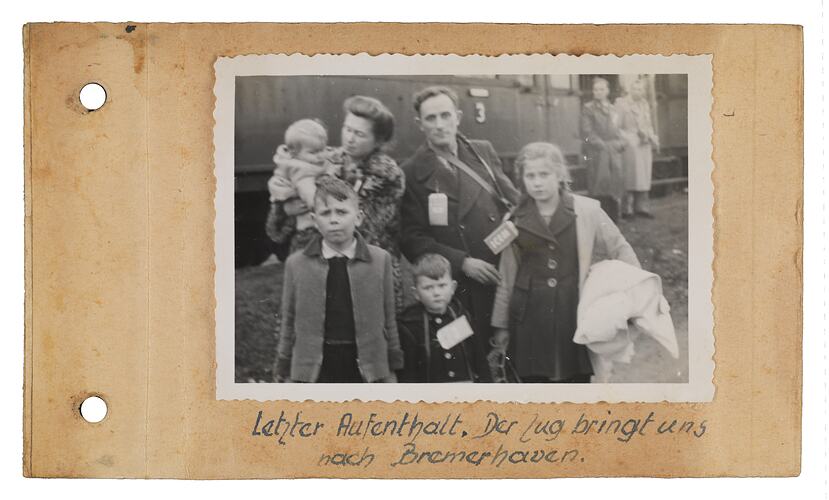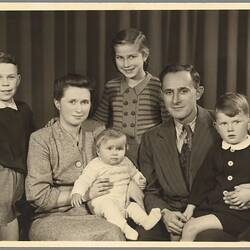Summary
Black and white photograph adhered to album page 1, of the Lischke family about to board a train to Bremerhaven, Germany from where they sailed to Australia on the MS Skaubryn, November-December, 1955. The family all have the ICEM (Intergovernmental Committee for European Migration) attached to their coats.
The inscription, handwritten by Walter Lischke in German, reads: 'Letzter Aufenthalt. Der Zug bringt uns nach Bremerhaven.' (Translation: 'Last stop. The train takes us to Bremerhaven').
This photograph is one of a series of forty black and white photographs adhered to pages within a small album. The photographs were taken by Walter Lischke, before, during and just after his migrant voyage to Australia with his wife and four children on the MS Skaubryn in November-December 1955. Walter put the photos in the album after arriving, entitled 'Our Australian Trip 20.11 - 31.12.1955...Our dear grandmother', and sent it back to his wife Gerda's mother in Germany. After she died three years later, the album came back to the family in Australia.
The album, with each photograph annotated in German, commences in Bremerhaven from where the family departed Germany, and follows their journey to Australia. Also refer to record HT53880, the camera with which Walter Lischke took all the photographs.
Description of Content
Family group standing next to train
Physical Description
Black and white photograph
Significance
Statement of Historical Significance:
This collection provides an evocative insight into one family's post World War II migrant journey, from processing and transport from Bremerhaven, Germany through the ship voyage, ports, arrival and processing at Station Pier, Bonegilla and their early settlement. The photo album compliments other diaries and photo journals in the Museum's collection and demonstrates the importance to migrants of documenting their journey and creating an enduring record of this seminal human experience. The camera with which the photographs were taken is also part of the collection, providing an often rare tangible link between the technology and what it produced and the technological era represented.
More Information
-
Collecting Areas
Migration & Cultural Diversity, Transport, Images & Image Making
-
Acquisition Information
Donation from Sybille Ims, 15 Apr 2015
-
Person Depicted
-
Person Depicted
-
Person Depicted
-
Person Depicted
-
Person Depicted
-
Person Depicted
-
Format
Photograph, Black & White
-
Classification
-
Category
-
Discipline
-
Type of item
-
Keywords
German Immigration, Migrant Hostels, Migrant Reception Centres, Migrant Workers, Shipboard Travel, Photography, Displaced Persons, Refugees

